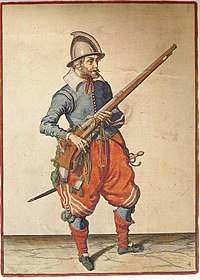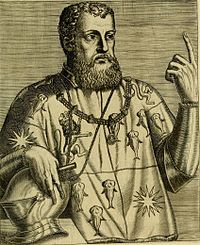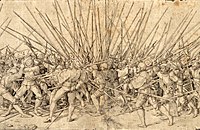The Great Ride South
| The Great Ride South | |||||||
|---|---|---|---|---|---|---|---|
 The battle of Naaxwiin | |||||||
| |||||||
| Belligerents | |||||||
|
|
| ||||||
| Commanders and leaders | |||||||
|
|
| ||||||
| Strength | |||||||
|
Lamarquist Chevauchée
|
Santamarist Expedition
| ||||||
| Casualties and losses | |||||||
|
4,000 killed 2,000 wounded |
11,500 killed 2,000 wounded | ||||||
The Great Ride South (french : La Grande Chevauchée ; Azawarecha : Keri Kabaiuhrani); the Santamaria Expedition in Nameria, is a conflict that opposed the recently founded Viceroyalty of Ultramer and its allies against the Namerian Empire in the modern day region of Tiamoncha. The Great Ride South is considered to be one of the founding events of Karazawa, as the army of the Viceroy Pierre de Lamarque was made up of contingents from all over his territories, dependencies, tributaries, and allies, from various Chichimecas horsemen to a full contingent of Karazawi being present, against a common enemy in the form of Nameria, who was already a threat to the previous Thlataloyan.
Prelude
Santamaria Expedition
The events that had transpired between 1523 and 1524 in the Thlataloyan had been closely followed by the Namerian Imperial Court, who had always dreamed of gaining full control over the Claudian Sea and secure its eastern border. The proclamation of the Viceroyalty of Ultramer in Saturnalia 1524 and is subsequent vassalization by the Aininian Kingdom was therefore a blow against the Namerian projects in the area, who could no longer hope to conquer the “Eastern Peninsula” without foreign powers getting involved. It was an especially harsh blow to Filippo De Santamaría, the Namerian Legate that had always lobbied the Court for a direct invasion of the Thlataloyan. With Ainin’s own conquests, many of his supporters at the Court started to be less receptive to his plans, and the funds, men, and equipment he had already gathered risked to be lost in the absence of an expedition. Despite the lack of clear Imperial support, De Santamaria nonetheless wrote a missive to the Court, announcing that he will take his expeditionary force as it is, and scout the south and south-east coast of the Claudian Sea in the hope to find good locations in which to establish ports and forts “In the hope of containing the pirates, the brigands, and the Aininians”. This need to “contain” foreign threats to re-establish order became the central theme of the Santamarist Party.
In spring 1525, Filippo decided to found Forte Falx, the central piece of what was to be expanded into a large network of outposts to secure the area by sending counter-expeditions againsts “pirates and brigands”. He then launched scouting, foraging parties, and embassies deeper inland, to explore the region and if possible to collect tributes and pledges of allegiance from the kingdoms that lived in the area. He notably defeated the Ayuk’ayl leader Ximonec and subsequently razed his city.
The encroaching Namerian presence was not ignored by Pierre de Lamarque, but he was too caught up in the Clouds War (1526 - 1527) to react immediately. For the next decade, consolidating his authority, stopping revolts and gaining new allies was all he had the time for, and even his closest partisans weren’t supportive of the idea of an expedition to directly oppose the Namerian Empire which was at the height of its power. He nonetheless allowed refugees from the kingdoms and tribes vanquished and displaced by Santamaria’s conquests to settle in Ultramer, and the Viceroy’s court was soon home to a collection of petty kings and their families that had found refuge there, hoping to one day fight back against the Namerians.
it’s finally in 1536 that the perfect opportunity presented itself to Lamarque : Santamaria, growing ever bolder in face of the lack of Aininian response, started to pursue resistants against his occupation on the other side of the theoretical border of the Viceroyalty, even burning a village in his quest to find and arrest the “brigands”. This would change the public opinion on the Namerian presence, and lead to an outrage that took even the higher spheres of the viceroyalty. Another was the constitution of an alliance of Chichimecas and Ayuk’ay tribes against Santamaria, and the arrival of an ambassador of said alliance to the Lamarque’s court. The embassy rallied to him the various chieftains and leaders in exile, who all petitioned the Viceroy to act against the Namerian legate in a ceremony secretly carefully arranged by Lamarque himself.
The Lamarquist forces
The internal situation of the Viceroyalty, even if still unstable, had nonetheless calmed down during the past decade as the Aininian presence became a fact of life. Thus, Lamarque decided to risk leading himself the expedition against Santamaria. With him, he took his closest circle of veterans soldiers, Aininian riflemen who had accompanied him since his first expedition, twelve years ago. They were accompanied by other veterans of the Triple Alliance : Mixtecs, Zapotecs, and Totonacs trained and led by both Aininian and Natives officers related to Lamarque’s clan and his close circle of friends and supporters. They were all equipped as per Aininian standards, with mix of pikemen, swordsmen, and riflemen. The elite troops of this army were trained in an early form of combined arms warfare, mixing pikemen and riflemen in their units. In total, Lamarque amassed six thousands men, all riding horses to avoid slow down during their journey. On their way south, this core was reinforced by Ayuk’ay and Chichimecas riders, who gathered up ten thousand men to fight alongside Lamarque.
A surprise for both side of the war was the Karazawi pledging an additional ten thousand men to be send to support the Aininians after they had received Lamarque’s call for help and demand for troops and assistance in his war against Santamaria. The Karazawi answered positively to this request, but miscommunications and still dangerous roads between the Viceroyalty and the Caconzicua led to Lamarque waiting for three days at what he thought would be the meeting point with the Karazawi before continuing south. Unknown to him, the Karazawi did send the troops, but through the “Mountain Roads” and directly toward Tiamoncha.
The Santamarist forces
As a legate, Felipe de Santamaria was heading a core army of full legio, around ten thousand men strong. Santamaria’s legio was composed mainly of veterans, who had already fought under their legate many time before. Most of these soldiers also brought their families with them to Forte Falx, and knew the lands of Tiamoncha by having spent the past 10 years policing the area. With time, Santamaria had managed to raise a second legio. Less competent, this new army never saw battle on its own, and was mainly used to staff forts and outposts or to raid undefended native settlements.
Namerians legionaries were famous for their heavy infantry, but they had also well integrated the principles of fire weapons, both cannons and rifles. The result were well coordinated, well protected, experienced, “mobile fortresses” once deployed on the battlefield, but still with enough flexibility to adapt to new situations.
Even though his rule was hated by natives, Santamaria nonetheless managed to obtain the begrudging loyalty of a number of tribes. These tribesmen were used as auxiliary cavalry and pikemen for the legio, never left to their own devices or to guard an outpost alone, by fear of a revolt.
The Great Ride South
In the end of May 1536, Lamarque and his men crossed the border between Ultramer and Tiamoncha. Santamaria had expected such a reaction from Ultramer but not that the Viceroy himself would lead the army. To stall for time, he sent ambassadors to negotiate with Lamarque, but these discussions quickly went to nowhere as Lamarque refused to back down and demanded the restoration of all the kings that Santamaria had deposed during his campaigns and the restitution of all of their lands. No compromise was found, because neither side was seeking one.
Meanwhile, Santamaria gathered his own troops : most of his first legio went with him to stop Lamarque, with younger and less experimented elements from the second legio to complete them and form a full army of ten thousands men. Six thousands auxiliaries strengthened this force, foraging and scouting alongside the Legio’s equites. Learning that Santamaria left Fort Falx, Lamarque marched forward to meet him, seeking the confrontation. Alongside the way, Lamarque strengthened his own forces with various rebels and tribal troops who rose up against Santamaria. The exact number and quality of these reinforcements are unknown, but were more than likely a comfortable addition to the Lamarquists numbers.
Battle of Ankiwam
As they moved closer to each others, both armies scouts and foragers started to cross path and small skirmishes multiplied. After two week of march, Santamaria choosed to take a defensive position on a hill on the right bank of the Higin river, near the town of Ankiwam. At first, Lamarque was at first unwilling to meet Santamaria there, but ignoring him and leaving Ankiwam to the Namerians would mean having to find another way to cross the Higin river, which could take days, and would then leave Lamarque’s supply lines undefended against any attack from Santamaria. Finally, Lamarque decided to fight there, planning a cavalry assault through the main, gentle, slope of the hill, while some of his most experienced infantry would go around and attack on the other, more uneven, slope. The simplistic and bold plan ultimately failed because of the competent Namerian artillery and riflemen managing to stop the main charge and to slow down the infantry to the point of uselessness. Despite relatively minor casualties, Lamarque decided to not risk a certainly more bloody second assault and ordered the retreat of his army back to the city of Omgwimin, to the north.
The Little March North
Seeing the Lamarquists moving back, Santamaria decided that, rather than wait for them to come back, he would pursue them and shadow the Aininian army to harass and weaken it, keeping the pressure to remain on the offensive. Aininians would nickname this episode the “Little March North” in contrast to the nickname they had given to Lamarque’s triumphant ride southward. The morale of his army, constantly attacked by the Namerians on their rear, was at its lowest and Lamarque had to, more than once, patrol himself and give speech to individual units to convince them to continue forward. The small “Nuit Blanche” clash is an example of such dedication of the Ultramer leadership to reinvigorate his men, fighting on the walls of their encampment against the Namerians skirmishers that had launched a night assault on them.
While not a tragedy for either side, very few men died during the small fights, it nonetheless showed that the Ultramarists had lost all their momentum. It is more than likely that the "Nuit Blanche" was only a premise of some larger attempt by Santamaria to isolate and crush the Aininians once and for all, and it is possible that he would seek a real battle not long before Lamarque and his troops reached Ongwimin, if it wasn't for the sudden arrival of the Karazawi.
The Karazawi March
Unknown to Lamarque, The Caconzi had indeed prepared a full expedition to go help the Ultramarists, but they did not go where the Viceroy had thought to be the rallying point. Because of delays and bad luck, these communications had not reached the Caconzicua in time and thus, instead of going to the north-west to re-inforce their Aininians allies, the Karazawi instead went straight west through mountain roads and valleys still unknown to both Lamarque and Santamaria, recruiting local Chichimecas, Nuhmu, and Masipijni mountainmen to help them navigate this intricate natural labyrinth and scout the area beyond. Once in Tiamoncha, they quickly met Anti-Santamarists Chichimecas who helped them join the Aininians.
Because Santamaria had no reason to believe reinforcements would come to the help of the Ultramarists from his rear, he focused his attention entirely on Lamarque's expedition. It's only too late that his scouts alerted him to the presence of the Karazawi columns, who had already occupied key crossing points of the Higin River.
This unexpected event forced Santamaria to abandon the pursuit of Lamarque and return south, hoping to face the Karazawi before he was entirely cut off from his supply lines. Lamarque and his men thus reached Ongwimin without further problems and its while resting there that Karazawi messengers reached them. Sizing this opportunity, the Viceroy immediately went forward with all his men.
Battle of Naaxwiin
It's on a hill near the town of Naaxwiin that Felipe de Santamaria decided to set his camp. The settlement was close to one of the bridges that allowed the crossing of the Higin River, and which was currently occupied by the Karazawi. After a night of rest, Santamaria ordered a first attempt to take the bridge, to no avail. After multiple charges, other methods were tried : from building a new bridge further downstream to night assaults. All in all the Namerians wasted three days, unable to make any meaningful gains.
It's after this first confrontation that Lamarque and his expedition arrived. Stuck between the two armies, Santamaria ordered a final sortie. Keeping his fortification to his south as a way to cover his rear, he faced the Ultramarist troops on the open battlefield. Unsurprisingly, the Karazawi exploited the opening to cross the bridge and flank the Namerian Legio despite being under fire from the artillery left behind to defend the fort.
Encircled, the Auxilliaries panicked and fled, creating the confusion among the less experienced legionaries. Seeing the situation was now unwinable, Santamaria ordered the retreat to the fort before the Karazawi could completely encircle them. However the pressure on the Legio was too high and most of the non-veterans units ended up routing and, to not slow down his men, Santamaria was forced to abandon his field artillery. He and most of his veterans cohorts nonetheless managed to reach their camp, which was now completely surrounded. Lamarque, now in command of both the Ultramarist and Karazawi armies, attempted to negociate the redition of Santamaria. It's the morning after the failure of these negociations that the assault of the fort began. It ended with the last stand of the first cohort which even after the death of Santamaria on the fort's walls, refused to surrender until all but two of them were left.
Aftermath
The news of Santamaria's defeat and defeat reached tardily Fort Falx and other Namerians outposts. Santamaria's second in command, now in charge, decided to abandon most of the distant forts and to condense his troops on the areas close to the coast and other easily defensible position. It did not stop however a great number of tribes and subjugated states to revolt against the Namerians immediatly after hearing the new, cutting off some cohorts of Namerians away from the main force and decimating these isolate soldiers. Lamarque thus journeyed through Tiamoncha unopposed and when he reached Fort Falx, the settlement had already been abandoned by its civilian population who fled to the other side of the Claudian Sea, while a rather meager legionary force had stayed behind to cover them. This time, negociations were more successful and both the Namerians and the Lamarquists agreed to a truce while the legionaries waited for the return of the ships to leave Fort Falx. After a week of waiting, the Ultramarists entered the city without opposition, as the last Namerians ships just left.
Pierre De Lamarque, the Karazawi Acháe (court lord), and all the petty kings and chieftains who had openly joined or supported the Ultramarist intervention met in the now abandoned Fort Falx to discuss of the aftermath of the war. The Falx Agreements created the Tiamoncha Federation with the status of protectorate of Ultramer. Almost the totality of Namerians forts in the area were dismantled, with a few exceptions which were to be maintained by the Tiamonchians until Ultramer sent troops to station there, as per the "Clause of Protection" of the Agreements. A year later, a second treaty, the Treaty of Texcotzingo was signed, serving as a complement and more detailed, more precise, version of the Falx Agreements. Before departing, the Ultramarists decided to rename Fort-Flax, "Port-Marque", which is still the french name of the modern day city of Kumanchi.
Meanwhile, even if the last remnants of the Santamarist faction had attempted to reform and to convince the Emperor to continue the expansion eastward, the wasted expedition as it was then called had convinced the Namerian Court that it would be too troublesome to oppose Ainin directly. Abandoning Tiamoncha once and for all, the Namerians refocused their attention on growing their Empire to the size of the late Palatinate.




